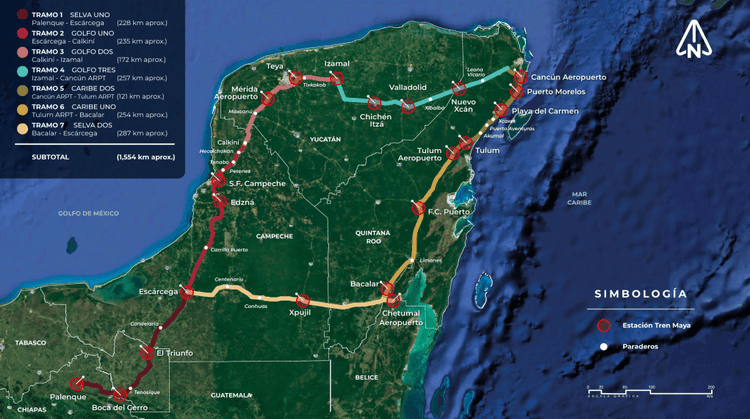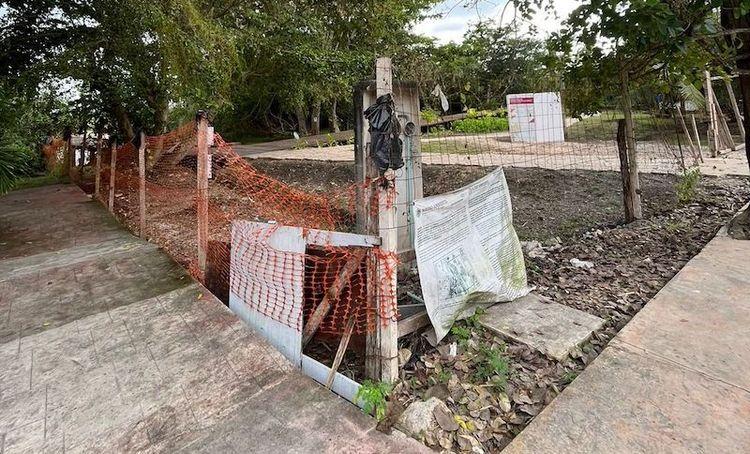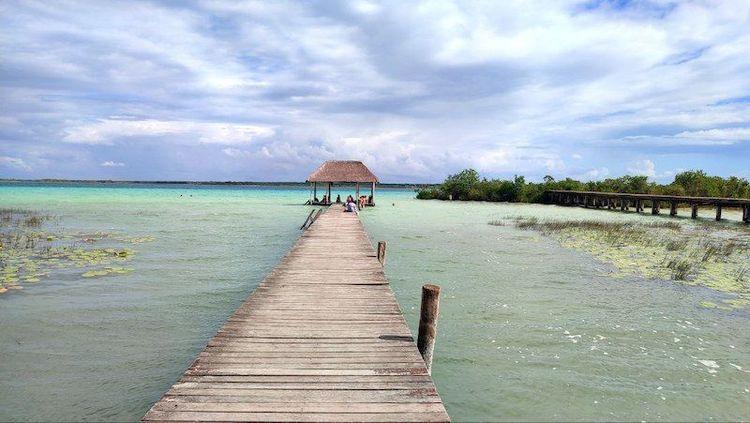The days of walking quietly along “the coast” and being at ease on the three modest public piers of the Bacalar Lagoon are numbered with the Maya Train project, which contemplates taking around 2 million tourists a year to the town of the same name in southeastern Mexico.

Map of the Mayan Train route in Southeastern Mexico. Image taken from the Fonatur website
In line with mass tourism that is expected in 2023, the Secretariat of Agrarian, Territorial and Urban Development (Sedatu), the agency responsible for land tenure policies and urban planning in Mexico, promoted in 2019 a program of works in the cities that will be connected by this new route.
Since 2021, Bacalarenses began to see with surprise the start of works such as the new municipal handicraft market, the public library, a baseball field, the remodeling of the central park and the municipal spa, and the main work, the “Bacalar Ecopark”.
This last project is being developed in the Bacalar Ecological Park, where the only five hectares considered a Protected Natural Area (ANP) of the coastal ecosystem known as the Bacalar Lagoon are located.
Héctor Hernández, a researcher at the Colegio de la Frontera Sur (Ecosur), a public scientific research center focused on sustainable development in the region, places the lagoon in the coastal cross corridor of southern Quintana Roo, which runs from Chetumal to the Caribbean Sea.
The corridor is of great importance and ecological fragility because of extensive wetlands, floodable lowland jungles, karst lakes, coastal lagoons, and microbial ecosystems that form reefs such as stromatolites, he considers.
An irregular ecopark rejected by the Bacalarence community
The Bacalar ecopark project proposes the creation of a spa, a camping area and environmental education activities, through interpretive trails (information plates) and the construction of an 800-meter square pier with a classroom, a laboratory, bathrooms and points of sale in its lower part.
“What this pier seeks is to give a sense of local identity, but it is also important because it is an educational element... to be able to give an understanding of the ecological preservation of the environment here in the Yucatan Peninsula,” said the head of Sedatu, Román Meyer Falcón, on his Twitter account in early September.
The ecotourism project proposal proposes a responsible and ecological recovery intervention of 3,365 square meters. It received authorization from the Ministry of Environment and Natural Resources (Semarnat), a agency responsible, among other things, for evaluating the environmental impacts that works and activities could cause to the environment, through letter 04/SGA/1491/2021.
The works began in July 2021, however, in November of that year ejidatarios, businessmen dedicated to ecotourism and locals entered the area and closed the works of the ecopark, arguing: federal contempt of a mandate from the Agrarian Court since 2016 to suspend works on the industrial estate and environmental damage by the real estate company Zenith, S.A. de C.V., which obtained the tender.
Negotiating and resolving these irregularities delayed the work and it was inaugurated hastily on the afternoon of November 19, 2022, nine months after the originally scheduled date. According to the owner of Sedatu, the work was built in 2021.
Causa Natura Journalism found that the inauguration was declared a day when construction materials had not yet been removed from the area or access restrictions, and the latter remained until the time of this publication, nor was the community notified.

Photograph taken 3 days before the delivery of the Bacalar Ecopark. Source: Daniela Reyes

Photographs taken on November 24, 2022, 5 days after the delivery of the Bacalar Ecopark Source: Martha Mattiello.
Urban and tourist development incompatible with Bacalar
Martha Mattiello, a member of the Guardianes Lagunares collective, a group of businessmen and volunteer collaborators who defend the lagoon and are dedicated to environmental education, explains that the rejection of the ecopark stems mainly from opacity and the exclusion of community opinions about the works by Sedatu and the construction company.
The project and the Environmental Impact Manifestation (MIA) were made public when work was about to begin. Urban development was imposed that does not match the priorities of the community, who demand as urgent the improvement of the three existing public accesses, a drainage system and the collection, separation and proper treatment of garbage, Mattielo said.
“If you look at it coldly, the public access project is good, because it is providing more public access for all the tourist demand that is coming, but at the cost of the loss of mangroves, of stromatolites, of population discomfort, things that could have been solved before, because the community wanted to get involved,” he said.
In addition, Mattiello expressed concern, since the community is in peak tourist season and the public docks are in poor condition, while the ecopark pier does not allow access to the public despite its inauguration.
For his part, Hernández adds that the “tourist vocation” that has been tried to impose on Bacalar since 2009 and the model of mass tourism in the south of Quintana Roo represented by the works promoted by Sedatu, do not match the environmental conditions of the town, which has the largest body of fresh water in the Yucatan Peninsula and the largest freshwater stromatolite reef in the world.
The lagoon is not healthy

Public pier next to the ecopark where you can see the loss of color of the lagoon. Source: Daniela Reyes
The lagoon “of the seven colors” increasingly loses its blue tones, replaced by a brown and greyish color with foams and sargassum, visible symptoms of its contamination.
The main threat to the conservation of the Bacalar lagoon is runoff from disordered urban and agricultural development, specifically deforestation, which will only intensify with the future mass arrival of tourists with the Maya Train, Hernández said.
In addition, the lack of a drainage system that prevents organic waste from being incorporated into the groundwater that nourishes the lagoon; the lack of environmental education due to the dispossession and privatization of the lagoon, which has only three public accesses; the erosion generated by tourism in the mangrove area that is found all along the coast; and the lack of will of the authorities to promote environmental conservation schemes.
For a sustainable cod
Faced with these scenarios, new alliances have emerged, such as the Union of Civil Society Organizations of Bacalar, who prepared a “Citizen Manifesto for a Sustainable Codfish”, where they demand territorial planning from the municipal authority and propose a Strategic Plan for Sustainable Development, which guarantees the human right to water and a clean environment through specific proposals.
“It is essential to understand that, without natural capital, there is no way to maintain any sustained development of the economy or human welfare,” says the Union.
Stopping deforestation, regulating livestock expansion and the use of fertilizers, wastewater sanitation, environmental education and monitoring water quality are some of the immediate actions suggested by the Bacalar Lagoon Report Card, carried out by the civil organization responsible for monitoring the health of the Agua Clara ecosystem, to stop the deterioration of the ecosystem.
There are other initiatives such as the proposal for the “Program for Common Management and Tourism Use of the Bacalar Lagoon” (Protur) and the Lagoon Guardians themselves, who are responsible for developing campaigns on good ecological practices for tourists, all aimed at building a better environmental history for Bacalar.
For its part, the academic sector insists that more strategies are needed to limit impacts to the ecosystem, such as restricting navigation one day a week; and, as well as a conservation scheme balanced between the need and interest in economic development and the conservation of the ecosystem.
“If we think about sustainable and sustainable economic development, it has to start from knowing what this economic development is based on, and if we talk about the south of Quintana Roo, it is based on its natural resources. A sustainability discourse cannot be consistent when it doesn't take into consideration the fragility of the ecosystem,” said Hernández.



Comentarios (0)